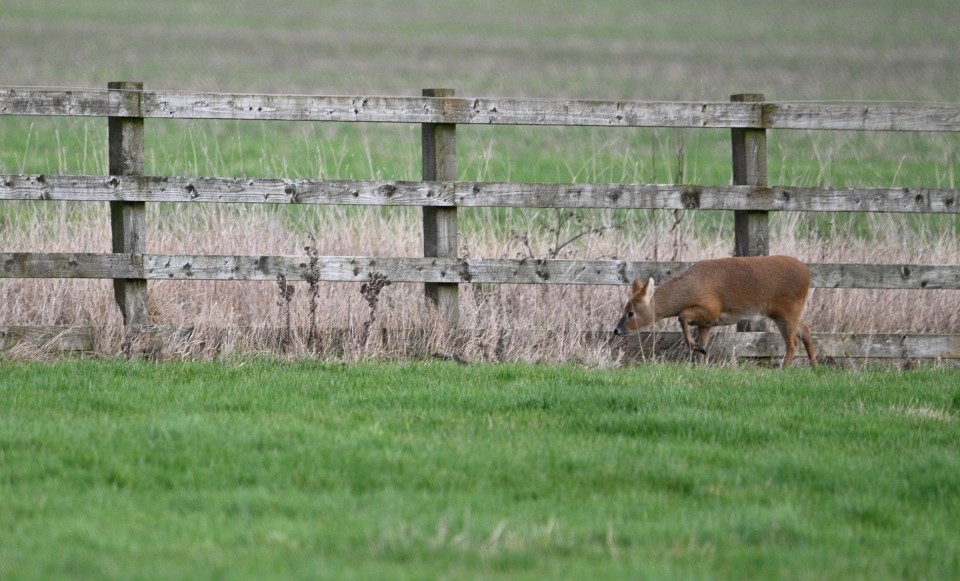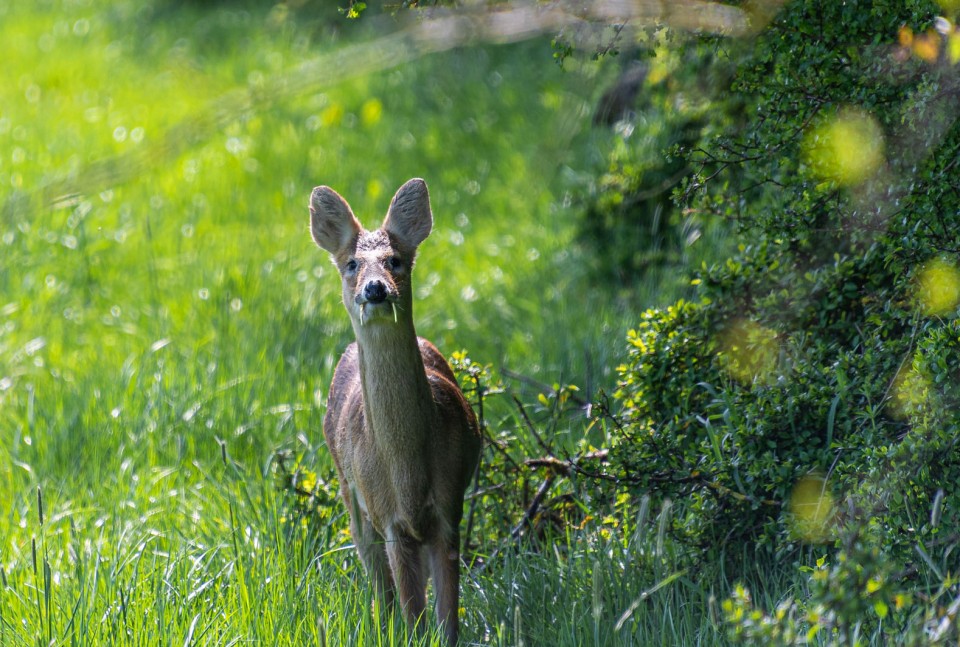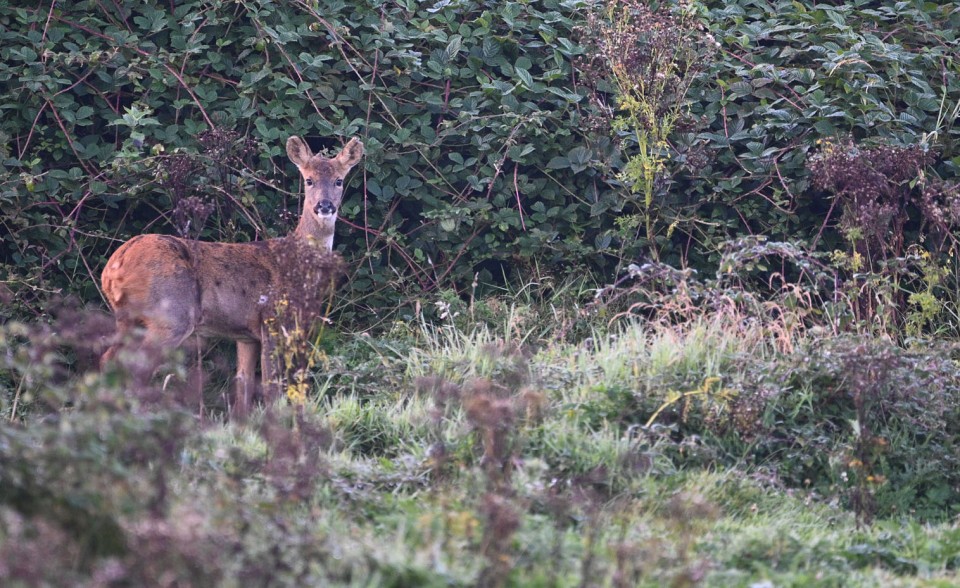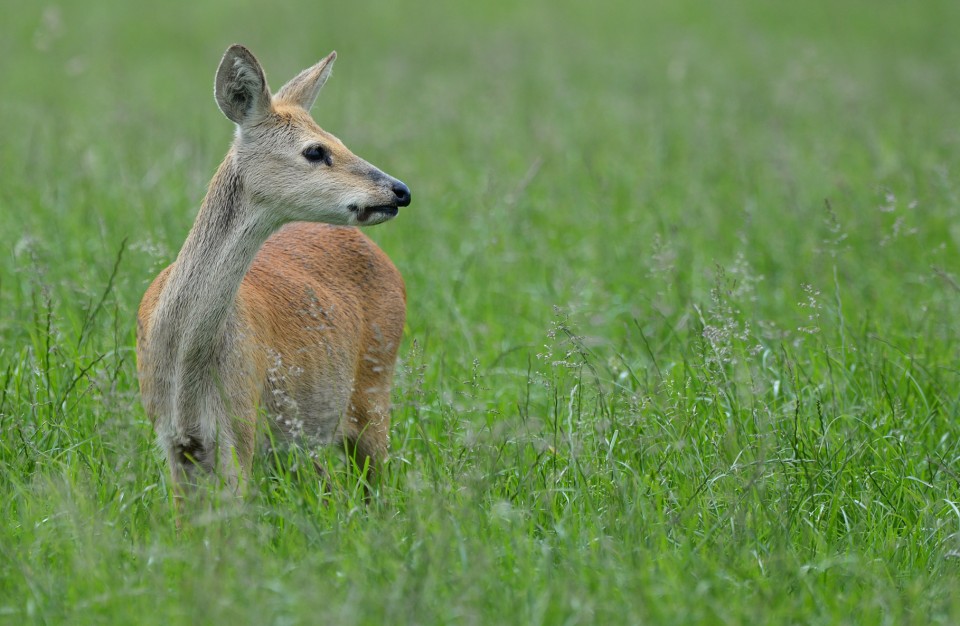Water Deer - Appearance
This is a small species in which, unusually for deer, the female is slightly larger than the male in both overall size and weight, a feature noted from birth in some populations. It is worth bearing in mind that much early data on this species was collected from specimens held at Whipsnade Zoo, and these appear to be considerably smaller than those found in the wild, up to 20% according to comparative data from Arnold Cooke and Lynne Farrell, even within the same county. Indeed, Raymond Chaplin has observed that while there's little, if any, difference in fawn size between park and wild animals, feral adults are typically heavier than those in parks. Additionally, some anecdotal information from stalkers suggests that farmland animals may grow larger and have a more robust appearance (in both body and tusk) than those in fenland/wetland habitat, largely through active stewardship by deer managers, but I know of no empirical study of this. Indeed, Cooke has previously observed that fenland bucks were generally larger than those on neighbouring farmland, theorising that fenland is a higher quality habitat than farmland for this species and the best territories were thus held by the fittest bucks.
Size and weight
Adults (i.e. those in their second year) stand 45 to 60cm (1.5-2 ft.) at the shoulder, are approximately 90 to 110 cm (3-3.6 ft.) long and have ears up to 11cm (4 in.) tall. In line with Allen's Rule, which predicts tails in cold climates are reduced to stumps or densely clad with fur, a small stubby tail measuring up to 6cm (2 in.) in length is present. The tail is, however, often difficult to discern because it's normally held down and largely enveloped by the surrounding fur, unless the animal is defaecating. While patrolling their territory bucks will often hold their tail horizontally, and on occasion I've seen does doing the same while walking about, although it seems less common among females.

Weight fluctuates considerably according to age and season, with yearlings lighter than adults and bucks at their lowest weights in February/March immediately after the winter rut. Understandably, females are at their heaviest immediately prior to giving birth and the combined weight of the fawns can double a doe's bodyweight.
At Branféré Zoological Park in France, Gérard Dubost and colleagues observed that adult non-pregnant does averaged just over 15 kg, while adult males averaged 14 kg - pregnant does were significantly heavier, with a litter accounting for some 12% of a doe's body weight in late spring. On average in the UK, males weigh 11-15 kg (24-33 lbs.), while females range 12-16 kg (26-35 lbs.). In their dataset from Cambridgeshire, Cooke and Farrell found the mean weight of bucks was 14.2 kg (31 lbs. 5 oz.) and that of females was 15.6 kg (34 lbs. 6 oz.)—the largest specimen of each sex was 18.5kg (40 lbs. 13 oz.) and 17.4 kg (38 lbs. 6 oz.), respectively. In his 2019 book Muntjac and Water Deer, Cooke referenced both bucks and does weighing 19 kg (42 lbs.), noting he had received reports of individuals shot in England that weigh in excess of 20 kg (44 lbs.), while Yeong-Seok Jo, John Bacus and John Koprowski, in their 2018 review of the mammals of Korea, gave a maximum weight of 21 kg (46 lbs). The highest (unconfirmed) weight I have come across thus far is the reference to a remarkable 24.5 kg (54 lb) doe shot after breaking cover in the Hsiashu district, between Chinkiang and Nanking, that Arthur de Carle Sowerby mentioned in a brief note to the China Journal of Science and Arts in 1924. Both sexes appear to reach their adult body weight at around 18 months old.
Appearance
The ears are large, rounded and well-furred and, coupled with large black eyes and a rounded black nose, give this species a teddy bear-like appearance, accounting for their colloquial name of “teddy bear deer”. Males, and very occasionally old females, possess elongated upper canines called tusks that may grow to 8cm (3 in.) in length and protrude down below from the top lip below the lower jaw line.

Despite their anatomical differences, fangs being hollow structures used to deliver or extract fluid, the superficial resemblance of these canines to fangs is the origin of the other common name for this species: the vampire deer. The tusks are loosely hinged in the upper jaw, allowing them a small degree of movement both backwards and forwards and side to side, the latter motion being necessary to allow for the cud-chewing practiced by all deer (see: Tusks). The tusks of bucks are surrounded by long white hairs, while females often present with a tuft of fur in the same location as the tusk that can cause confusion upon first glance (see: Doppelgänger deer? below).
The back is straight or slightly concave, with the rump held higher than the shoulders owing to the rear legs being longer and considerably more muscular than the forelegs. The feet are composed of cloven hoofs that are widely separable and associated with long heels, adapted for walking on soft marshy ground. The inguinal region (groin) contains two pairs of teats (some early sources suggest, incorrectly, that there is only a single pair) and is scantily covered with long hairs. Also present on either side of the groin is a shallow, curved, glandular depression reminiscent of the inguinal glands that many bovids possess either side of the midline between the penis and testes - water deer are the only deer species known to have these glands.
Doppelgänger deer?
Being of a graceful and rather delicate persuasion, their appearance is not dissimilar to our native roe deer (Capreolus capreolus), to which they are closely related. Indeed, the roe is the only species in Europe with which the water deer is likely to be confused and this was something that struck early naturalists, too. In the mid-1800s, William Forbes wrote a letter to taxonomist Richard Lydekker in which he noted how:
“The general similarity in appearance of Capreolus to Hydropotes has often struck me, and has even, I believe, led other into the error of mistaking one for the other!”.

Lydekker concurred, writing back:
“I can fully endorse the external resemblance between the water-deer and the roes, when seen at a distance in a park; although the difference in their movements affords a mode of discrimination.”
The short stature and long canines of the males of this species has also spawned the occasional big cat sighting in Britain. Indeed, the first local confirmed report of water deer from the wild outside of Woodwalton Fen was two sightings, probably of the same individual (buck), on a roadside verge at the edge of Bevill's Wood and Monks Wood in mid-October 1977. On 19th October, a buck was unfortunately hit by a car on the B1090 that runs between the two woods, but not before it caused quite a stir among the local police after it was reported by a passing motorist as a lion, prompting them to respond with a firearms unit. Arnold Cooke tells me that the carcass ended up in the local butcher's shop in Alconbury Weston.
Finally, there is some suggestion that the fur arrangement and colour around the mouth may allow does to masquerade as bucks. Females sometimes have a tuft which extends down from the top lip in the location the canine hangs in bucks and, in their 1970 paper to The American Naturalist, Russell Guthrie at the University of Alaska and Ronald Petocz at Calgary University proposed that this is a form of weapon automimicry. In other words, the tuft gives the impression of a canine without the physiological costs associated with producing one

It's certainly the case that the tuft can complicate sexing water deer at first glance, although a closer look is often all that's needed to be sure. Guthrie and Petocz imply that looking like a buck might make females less likely to be pestered by immature males, or allow them access to male-dominated resources. In the case of water deer, however, both drivers seem unlikely. Bucks appear primarily to assess readiness to mate based on scent and, in my experience, seem able to determine sex from substantial distance. Furthermore, does are free to move across male territories and hence aren't excluded from resources held by bucks during the rut. I wonder, instead, whether it perhaps has some anti-predator effect, giving any would-be attacker the impression that this deer is more formidably armed than it actually is. Speaking with Arnold Cooke about this, he told me that he tended to assume these tufts might be something does acquired when they were “getting on a bit”, pointing out that mature bucks can be even more whiskery in the same place on the top lip just behind the tusk, but it's just not as obvious in the field because of the tusk.